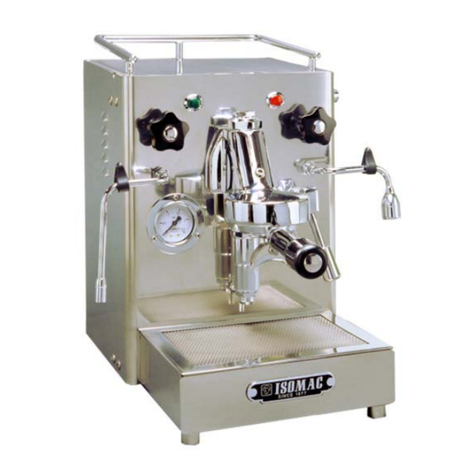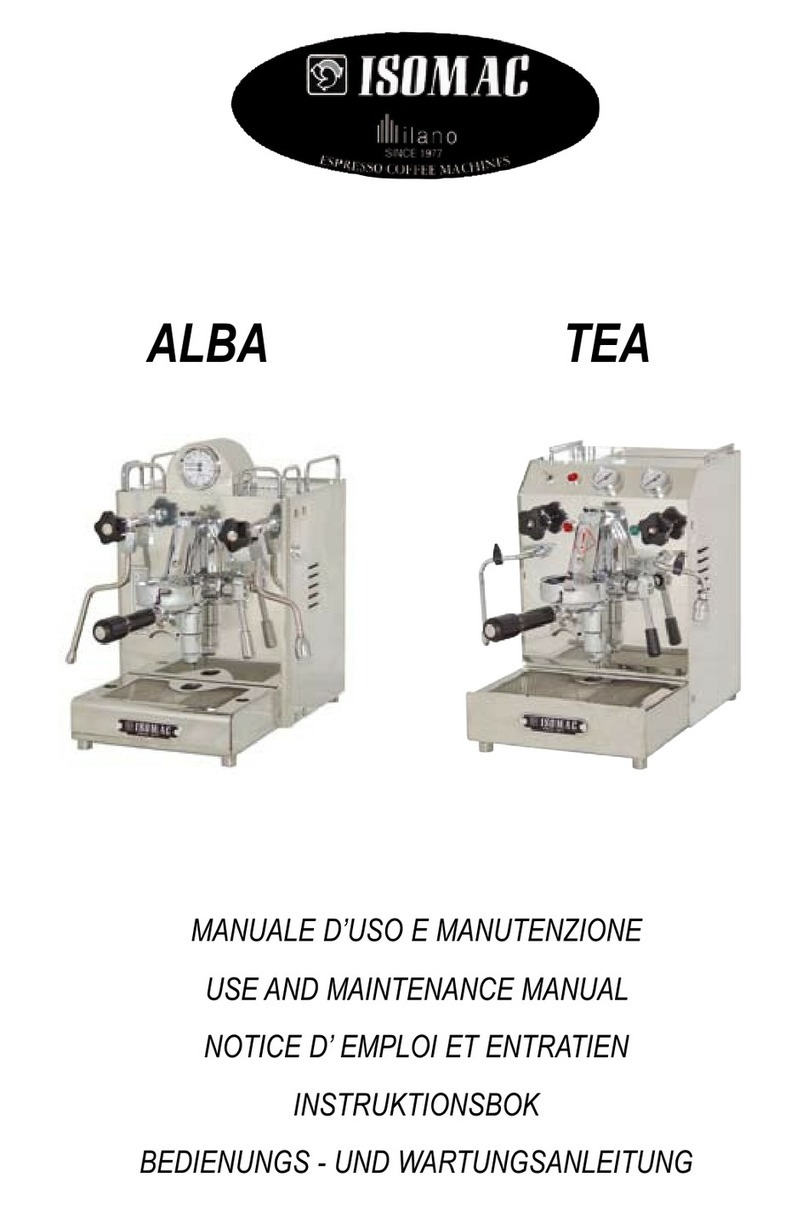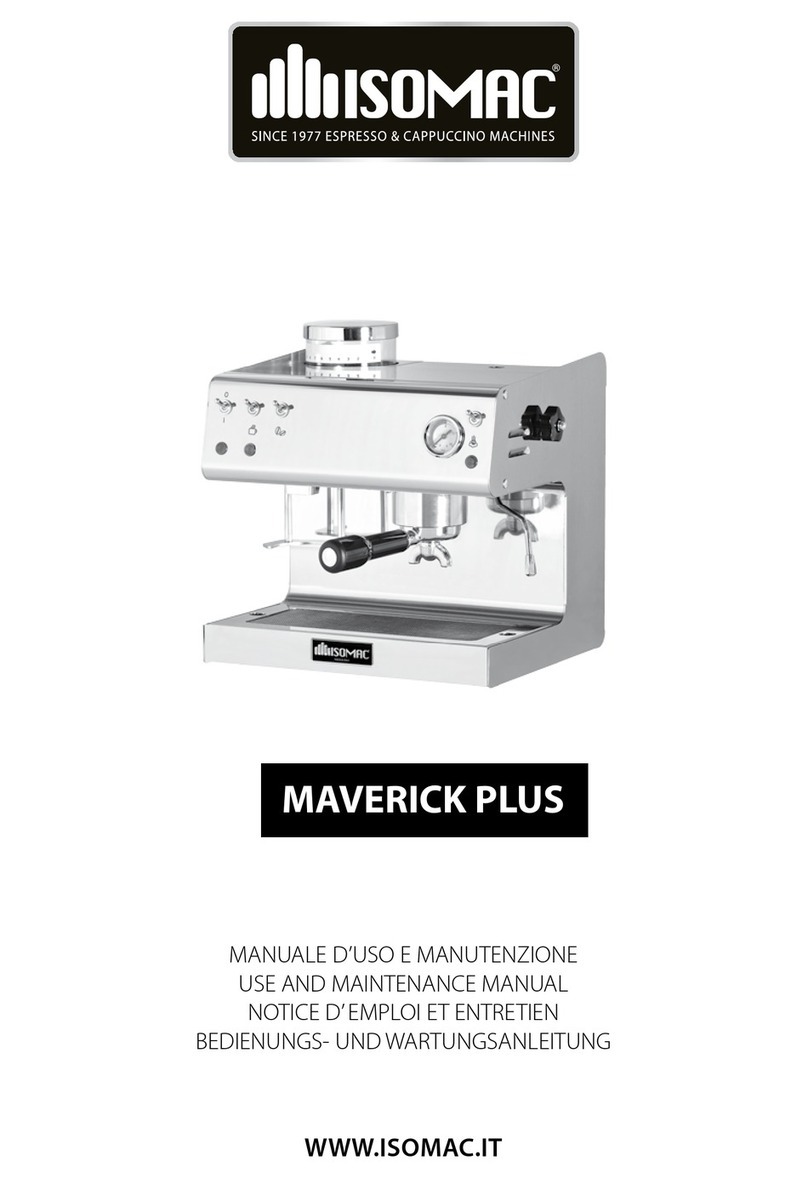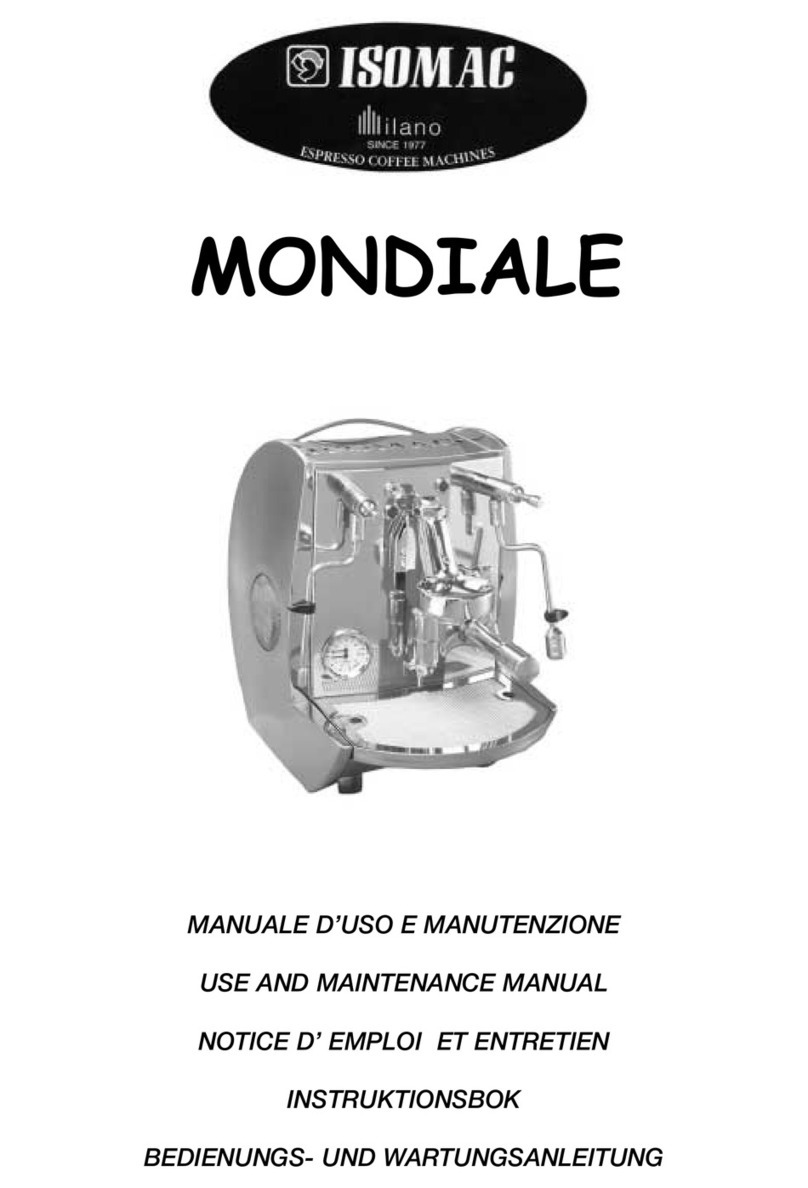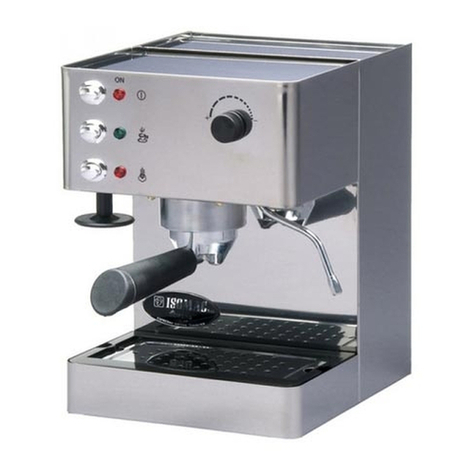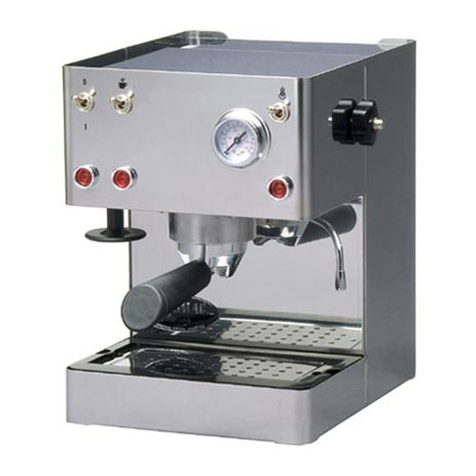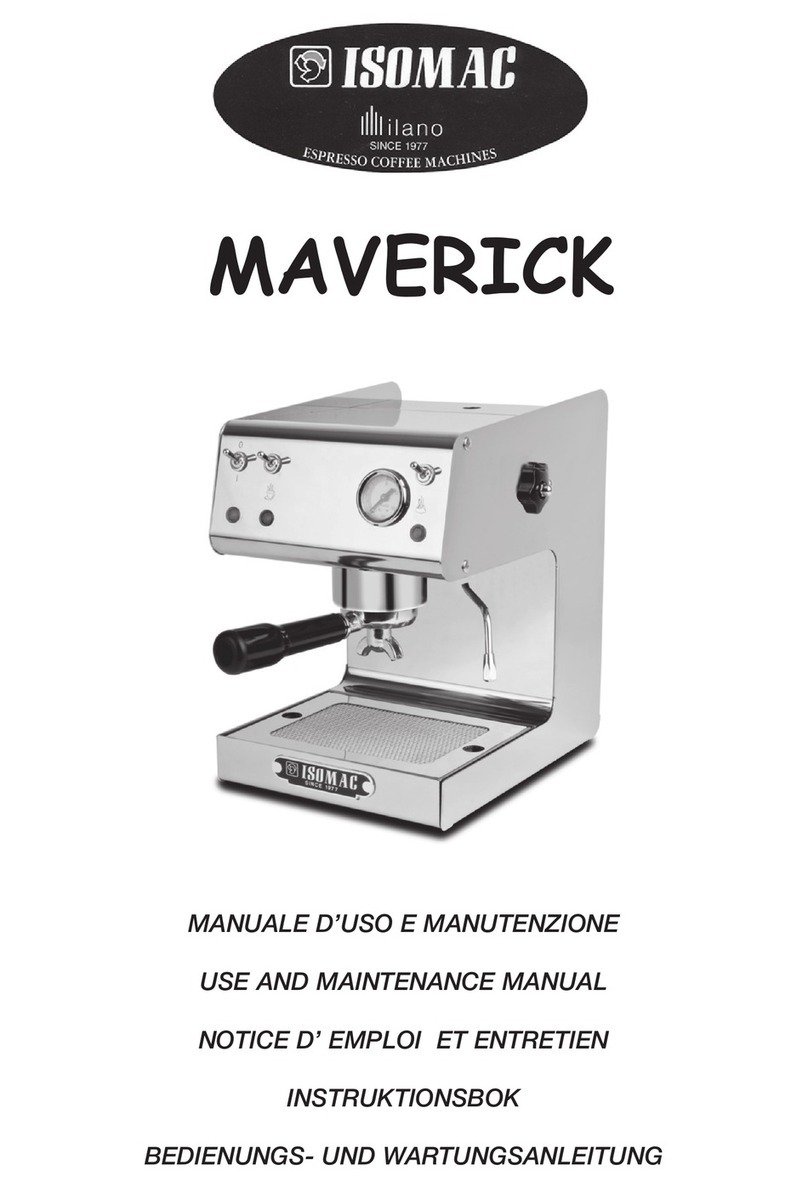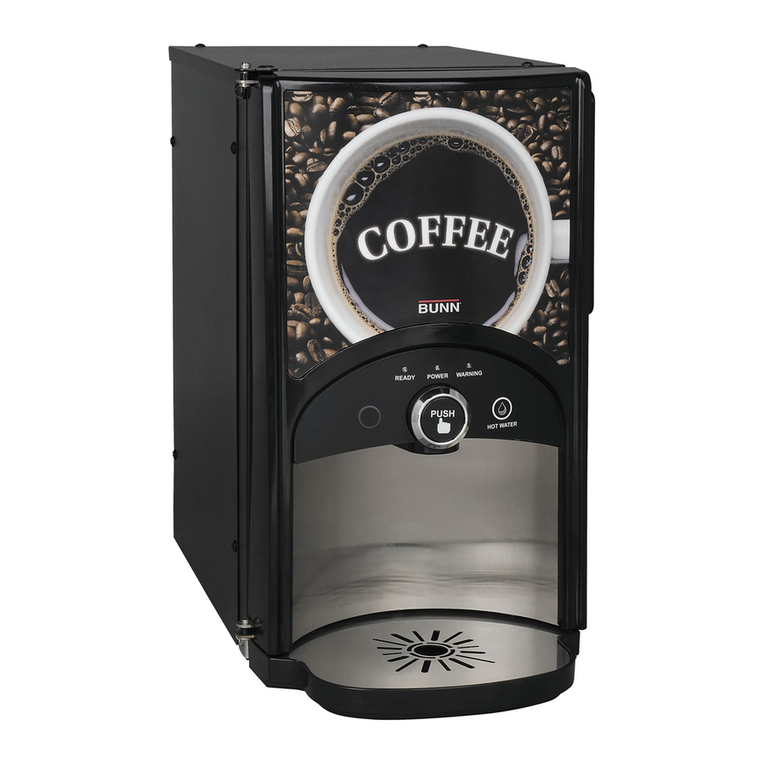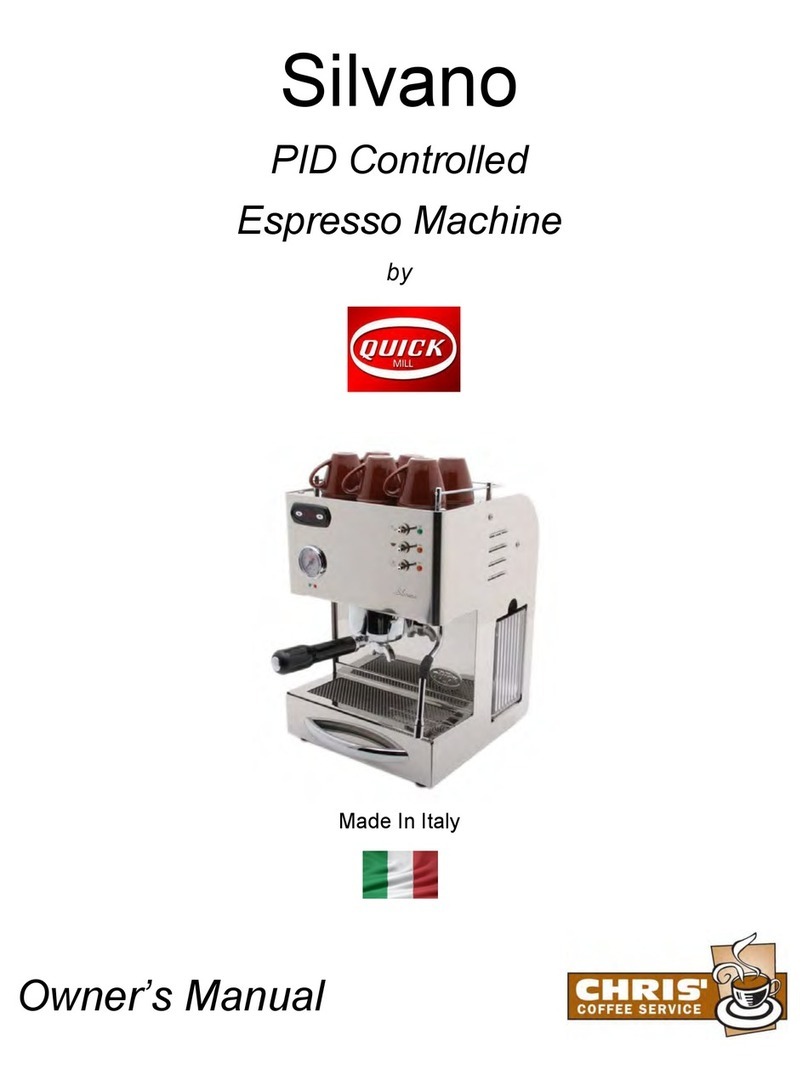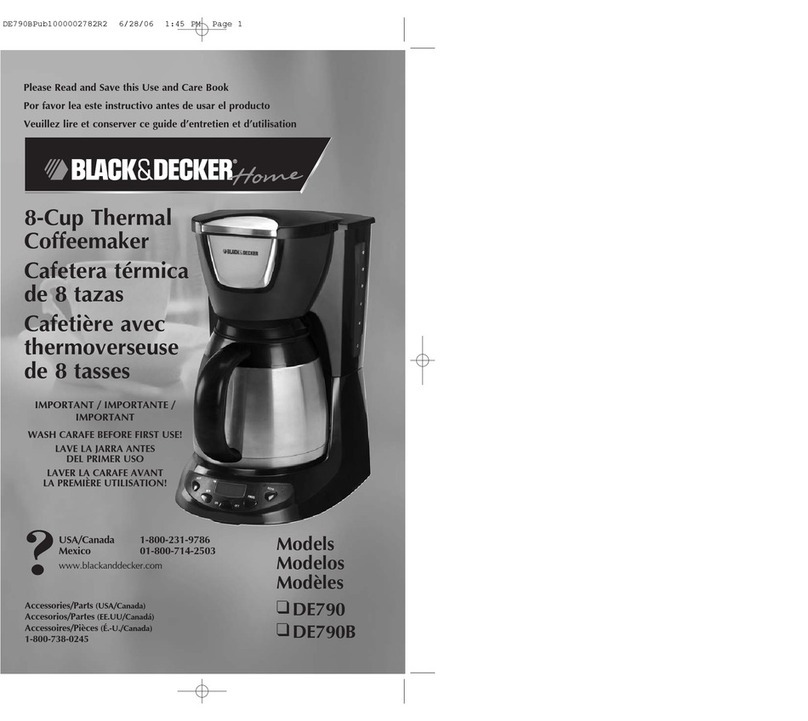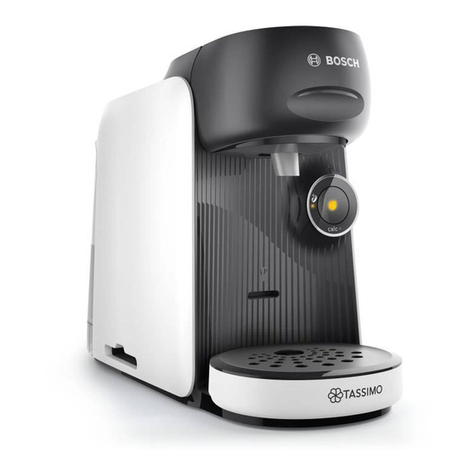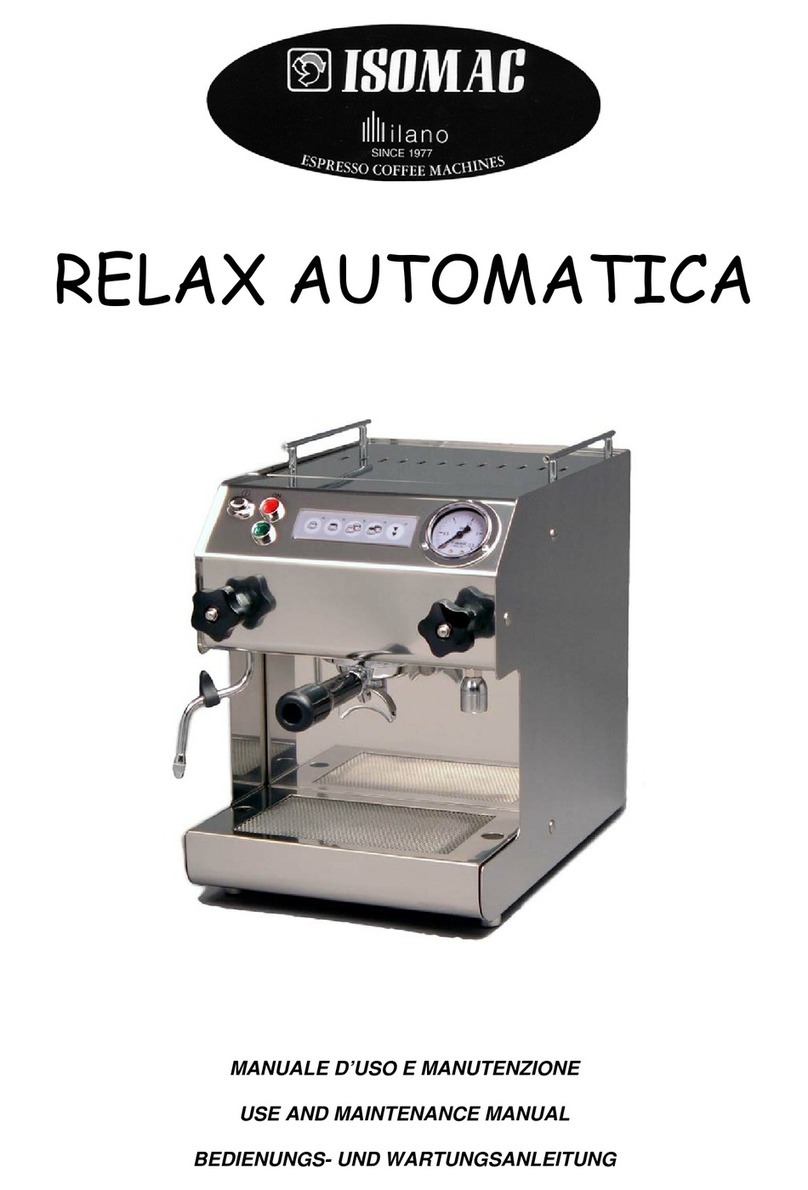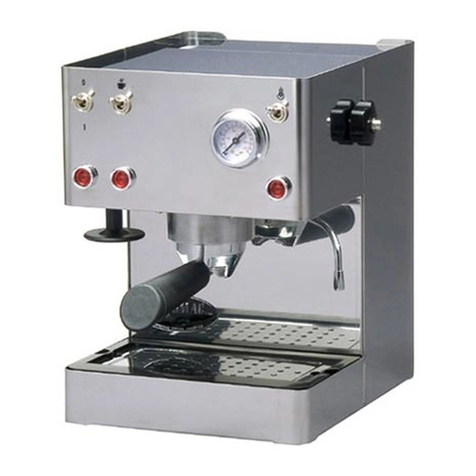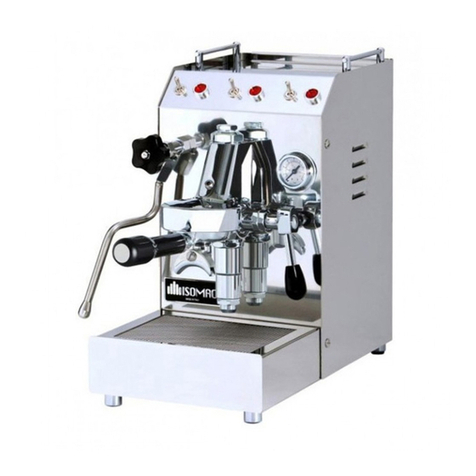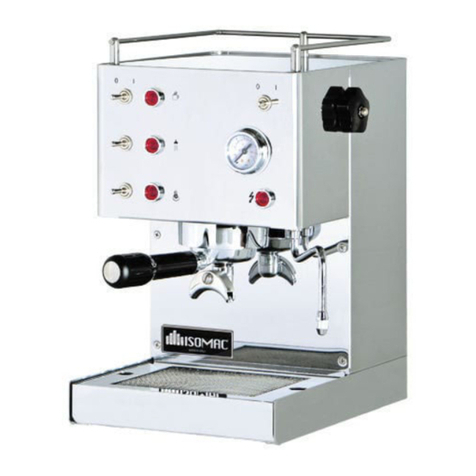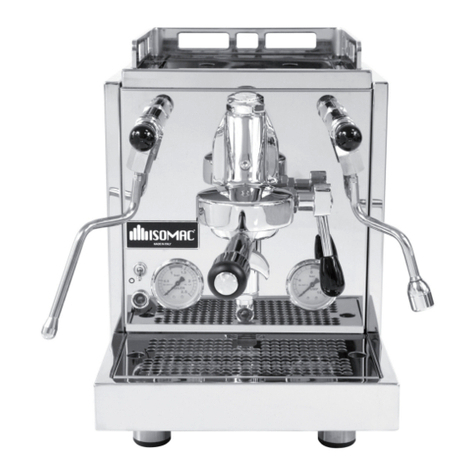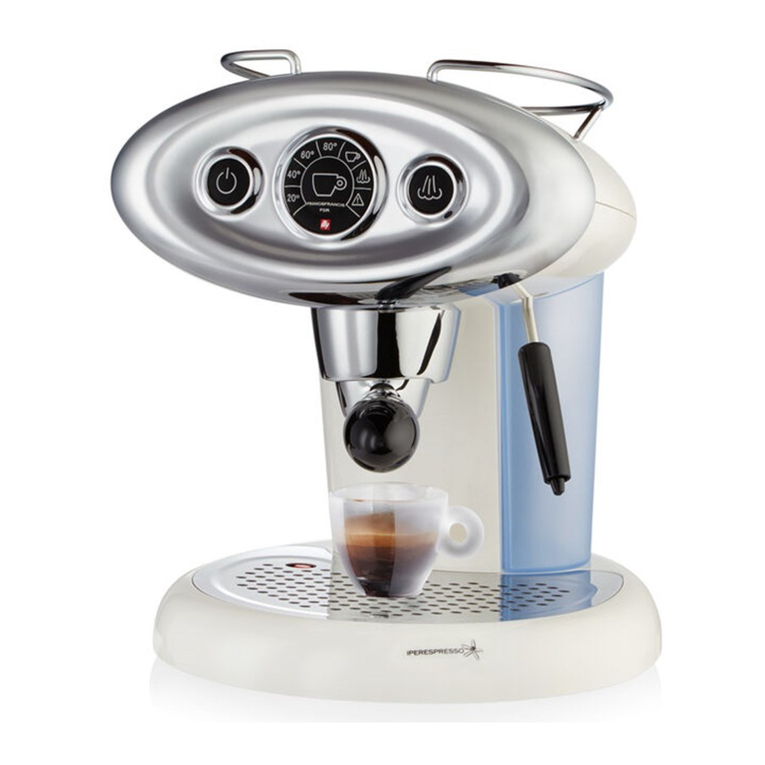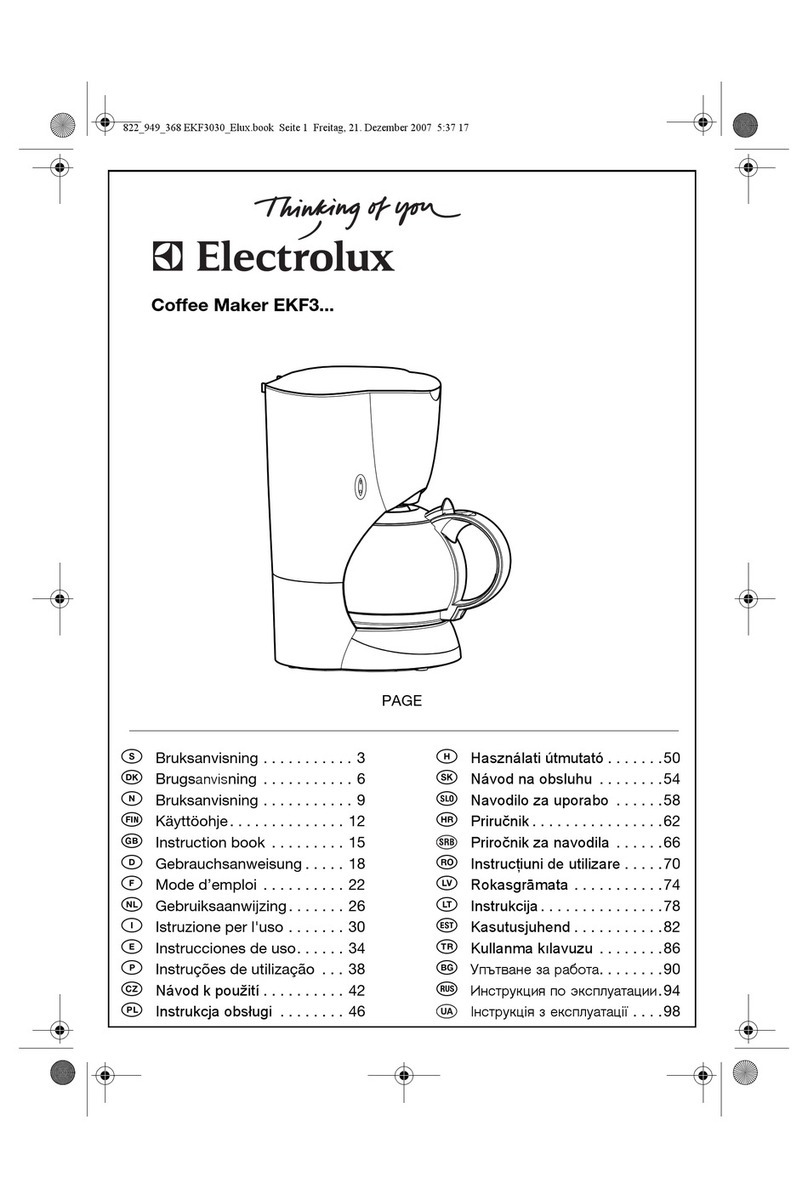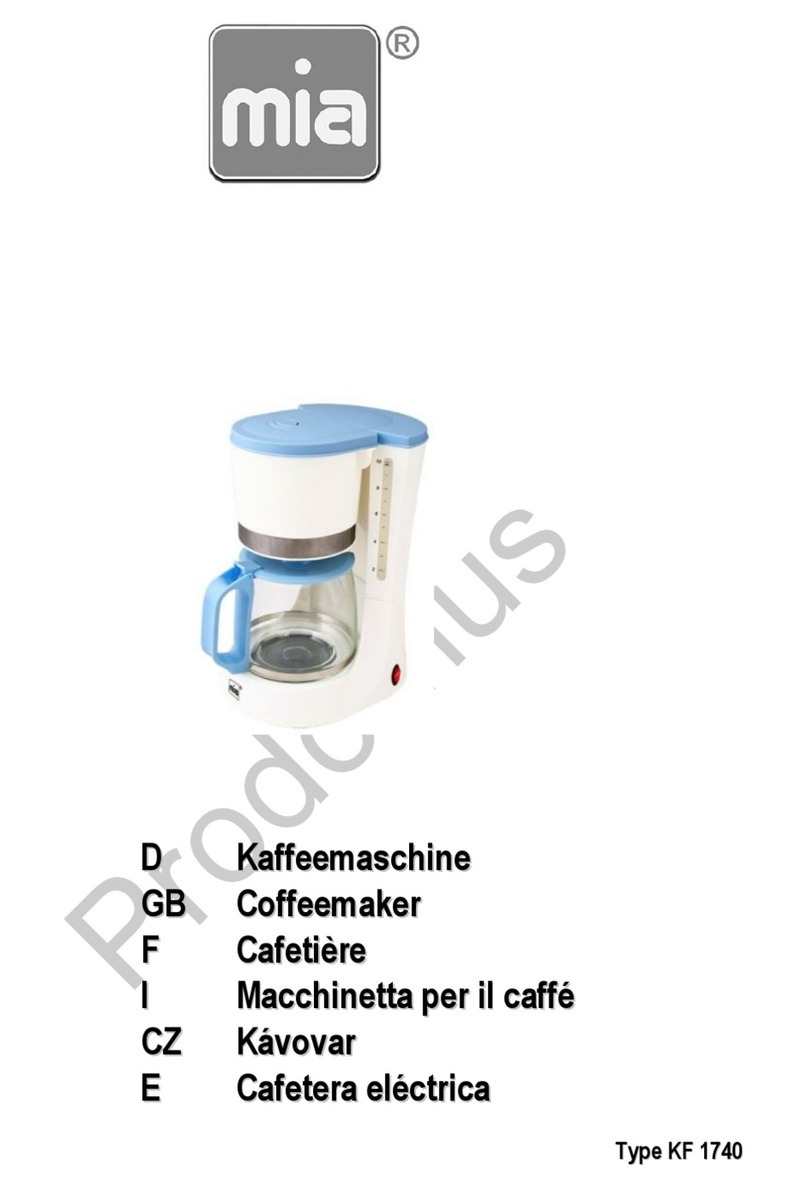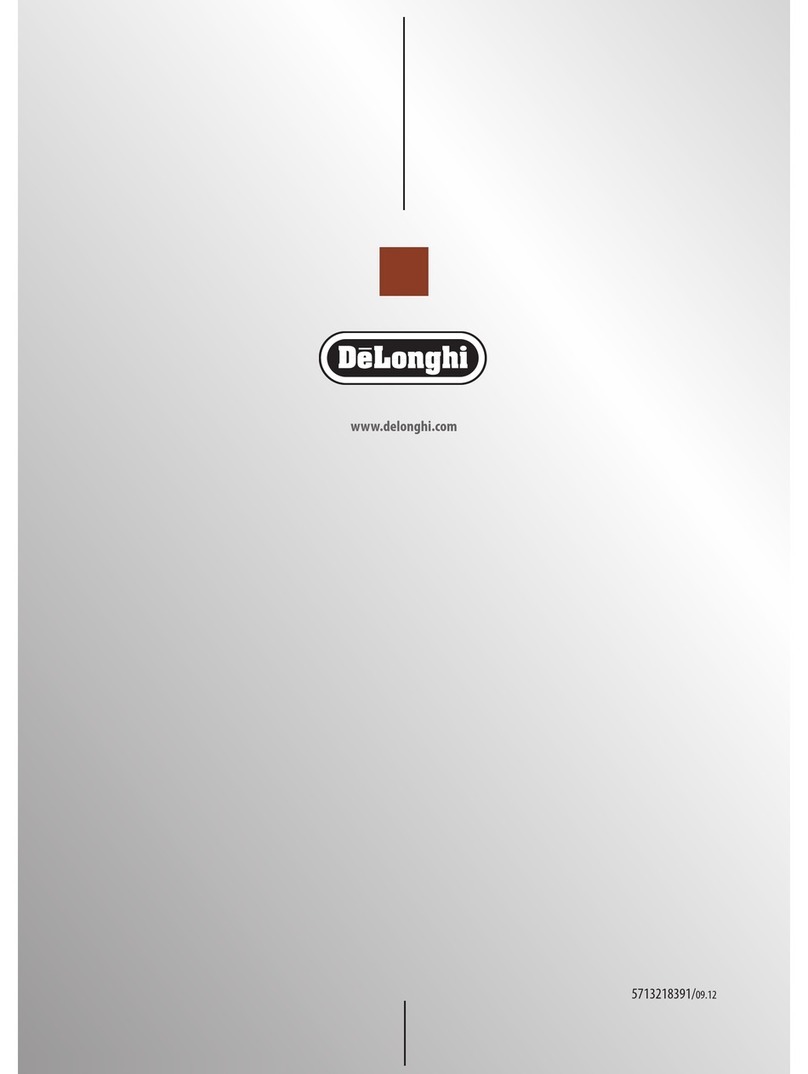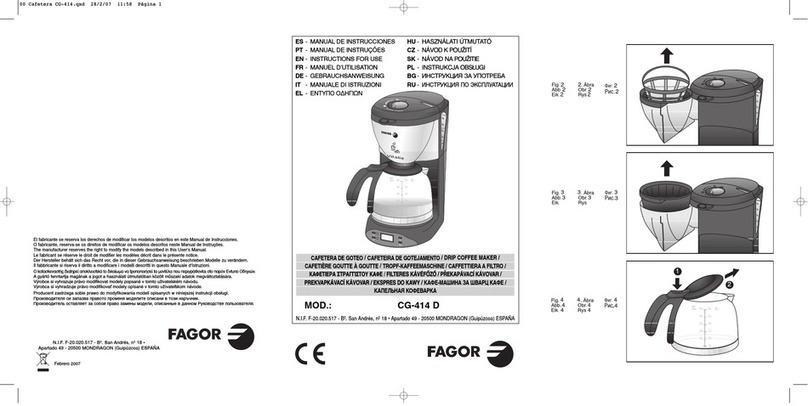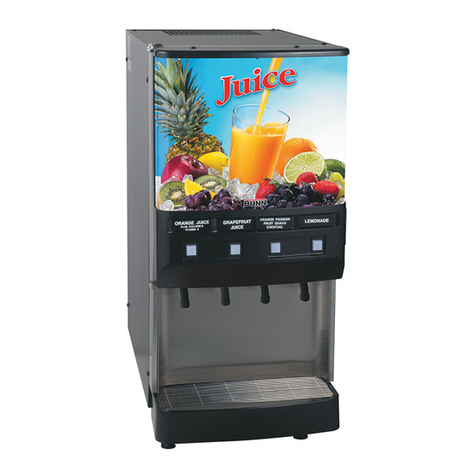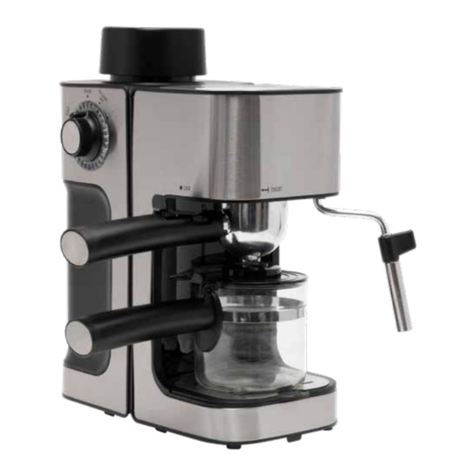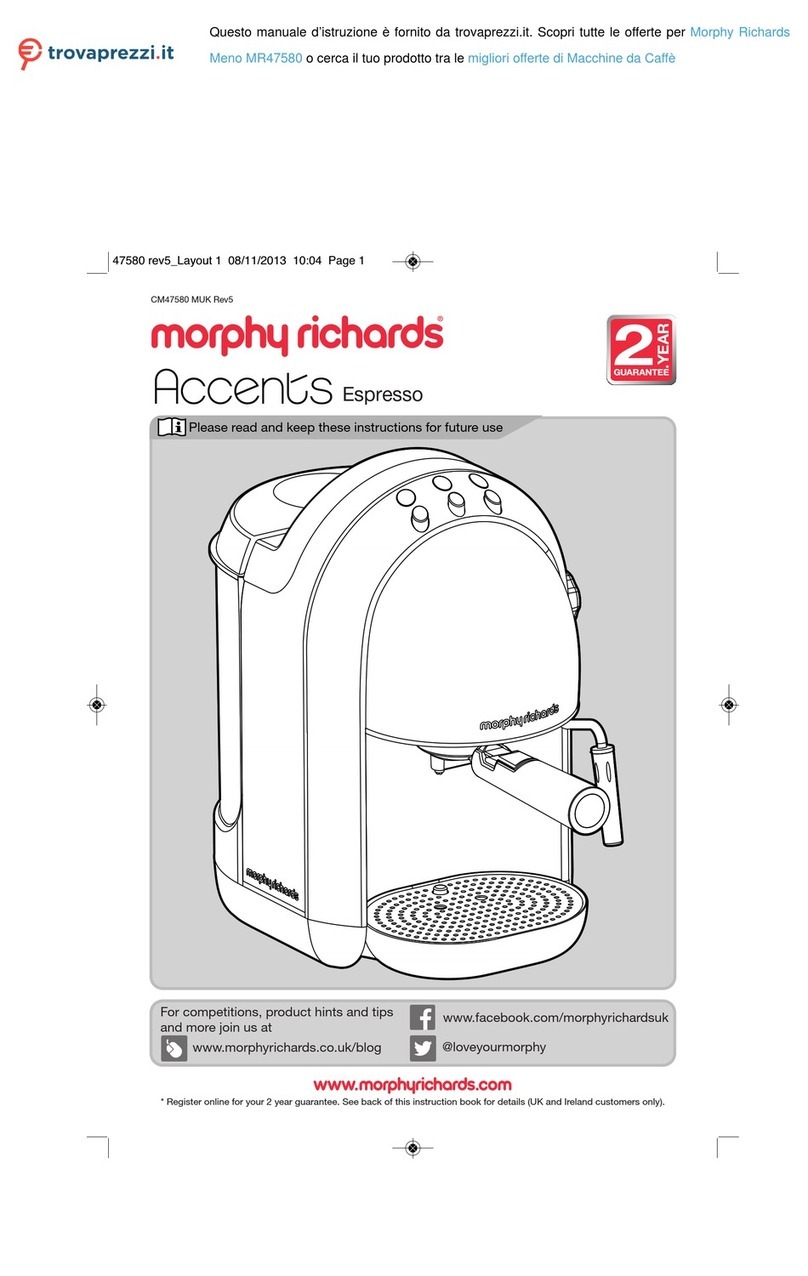12 13
6 – PREPARAZIONE DEL CAFFE’
Per ottenere un eccellente caffè espresso è importante utilizzare un
caffè di ottima qualità, ben torrefatto e giustamente macinato; la
macinatura è giusta quando il tempo di erogazione dei caffè è di
15-18 secondi per una tazza e di 30-35 secondi per due tazze.
La macinatura deve essere fatta al momento dell’utilizzo in quanto
il caffè, una volta macinato, perde entro breve tempo le sue capa-
cità aromatiche; se la macinatura è troppo grossa si otterranno
caffè chiari e leggeri e senza crema, se è troppo fine, caffè scuro
e forte con poca crema.
Le tazze calde contribuiscono a conservare alla giusta temperatura
il caffè appena erogato, si consiglia pertanto di collocare le tazze
prima dell’uso sull’ampia griglia portatazze (3) che consente lo
sfruttamento del calore irradiato dalla caldaia.
Attenzione! Evitare di coprire il piano scaldatazze con tessuti,
feltri, ecc.
Dopo aver collocato il filtro nell’apposita sede del portafiltro (12),
riempire il filtro con una dose di caffè macinato, sufficiente per
ottenere 1 o 2 tazze (7 gr. - 14 gr.), livellare e premere con il pres-
sino (25), ripulire con il palmo della mano il bordo del filtro da
eventuali residui di caffè ed agganciare il portafiltro al corpo del
gruppo (11) e spostarlo verso destra per fissarlo al gruppo stesso.
Predisporre le tazze sotto i beccucci erogatori ed azionare il grup-
po per mezzo del comando gruppo (20).
Raggiunta la dose di caffè desiderata, interrompere l’erogazione
agendo sul comando gruppo (20) e lasciare il portafiltro aggan-
ciato al gruppo.
Per l’esecuzione di altri caffè, sganciare il portafiltro (12) dal
gruppo, spostandolo verso sinistra, eliminare i fondi del caffè e
ripetere le operazioni sopra riportate.
Attenzione! Si consiglia di non toccare i gruppi e le
lance vapore e acqua calda quando la macchina è in
funzione e di non mettere assolutamente le mani sotto
i gruppi e le lance durante l’erogazione per evitare
possibili ustioni.
Si consiglia di lasciare inseriti i portafiltri, con i filtri
con i fondi di caffè, nel gruppo durante la giornata di
lavoro, per avere il portafiltro sempre a temperatura
ottimale.
Attenzione! Quando la macchina è nuova, il portafiltro può risul-
tare non allineato (perpendicolare alla macchina stessa) come
indicato nella fugura, senza per questo compromettere il buon
funzionamento della stessa.
Dopo un breve periodo d’utilizzo, il portafiltro andrà man mano a
posizionarsi nella posizione corretta.
A= Posizione del portafiltro chiuso con la macchina nuova
B= Posizione del portafiltro chiuso con la macchi- na dopo un
breve periodo d’uso.
7 – COMANDO GRUPPI E REGOLAZIONE TEMPERATURA
TERMOPID
Macchina con gruppi semiautomatici ad erogazione continua con
funzionamento a microinterruttore.
L’erogazione del caffè si ottiene azionando la levetta del gruppo
(20) posta sul pannello; portando la levetta verso l'alto, il microin-
terruttore ad essa collegato attiverà l'elettropompa che invierà l'ac-
qua in pressione al gruppo, il quale, grazie ai dispositivi interni,
permette prima la preinfusione e successivamente l'infusione del
caffè nelle più differenti condizioni d'uso. Raggiunta la quantità di
caffè desiderata, riportare la levetta (20) verso il basso, posizione
di arresto, per interrompere l'erogazione.
7.1 - REGOLAZIONE DELLA TEMPERATURA IN CALDAIA
TRAMITE IL CONTROLLO TERMOPID
Il Termopid e’ stato impostato dalla fabbrica a 122°C. Per poter
intervenire sulla regolazione procedere come segue:
- premere il tasto (▼); non appena sul display compare la scritta
“PRG” premere il tasto (▲) ;
- quando il display visualizza la temperatura della caldaia , impo-
stare con i tasti (▼) e (▲) il valore della temperatura desiderata,
da un minimo di 80C° ad un massimo di 133C°.
- dopo 3 secondi dalla pressione dell’ultimo tasto il dato è memo-
rizzato ed il display visualizza la temperatura.
NB:
Il dispositivo controllo temperatura Termopid e’ stato
impostato a valori di fabbrica per un caffè espresso
ottimale.
Durante il riscaldamento e l’erogazione di caffè o
acqua la temperatura può avere un’oscillazione di 5 ÷
6°C in + o in - rispetto a quella impostata.
E’ stato inserito anche un avvertimento: dopo i 127°C il
display del Termopid visualizza la temperatura ma ad
intermittenza; e’ del tutto normale, in quanto questo
avverte l’operatore che il caffè non uscirà buono se
erogato con una temperatura cosi alta.
8 – PRELIEVO ACQUA CALDA
MODELLO MONDIALE - KIA
Collocare un contenitore sotto la lancia erogazione acqua calda
(9), premere la levetta snodata (6) verso il basso per consentire
l’erogazione dell’acqua; raggiunta la quantità di acqua desiderata
interrompere la pressione, la levetta ritornerà nella posizione d’ar-
resto interrompendo l’erogazione.
MODELLO TEA - MILLENNIUM
Posizionare un contenitore sotto la lancia acqua calda (9), ruotare
in senso antiorario la manopola del rubinetto acqua (6), uscirà
acqua a 95°C circa, dalla parte inferiore della lancia acqua (9).
Al raggiungimento della quantità di acqua desiderata ruotare in
senso orario la manopola del rubietto acqua (6).
Posizionare un contenitore sotto la lancia vapore / acqua calda
(24), ruotare in senso antiorario la manopola del rubinetto acqua/
vapore (23), premere l’interruttore acqua calda (21).
Uscirà acqua a 95°C circa dalla parte inferiore della lancia va-
pore / acqua (24). Al raggiungimento della quantità di acqua
desiderata ruotare in senso orario la manopola del rubietto acqua/
vapore (8) e premere nuovamente l’interruttore acqua calda (21).
9 – PREPARAZIONE DI ALTRE BEVANDE
9.1 LATTE, CAPPUCCINO ED ALTRE BEVANDE CALDE
Attenzione! Pericolo di scottature! All’inizio
dell’erogazione possono verificarsi brevi spruzzi di ac-
qua calda. Il tubo di erogazione può raggiungere tem-
perature elevate: evitare di toccarlo direttamente con
le mani.
Prima di scaldare qualsiasi bevanda, far uscire con cautela un po’
5 – PRIMA MESSA IN SERVIZIO
Per mettere in funzione la macchina per caffè espresso seguire
attentamente le indicazioni riportate di seguito:
aprire l’imballo esterno, estrarre la macchina da caffè ed accertar-
si dell’integrità della stessa. Verificare la presenza degli accessori
di cui la macchina è dotata (vedi paragrafo 4) posizionare
la macchina sopra ad un piano orizzontale togliere il coperchio,
estrarre il contenitore dell’acqua (posto all’interno della macchina)
e sciacquarlo riempire il contenitore con acqua pulita, posizio-
narlo nuovamente nella sua sede ed inserirvi i tubicini di silicone.
Chiudere il coperchio della macchina
Attenzione! Prima di procedere all’allacciamento elet-
trico, bisogna accertarsi che la tensione di rete corri-
sponda alle caratteristiche indicate nella targhetta dati
posta sotto la base della macchina.
Collegare il cavo di alimentazione alla macchina.
Accendere la macchina posizionando l’interruttore on/off (1)
sulla posizione “I”. L’accensione della lampada (14) conferma
l’alimentazione elettrica.
L’autolivello si metterà in funzione per il caricamento dell’acqua in
caldaia fino a quando la stessa raggiungerà automaticamente il
livello predeterminato; il controllo dell’acqua in caldaia è automa-
tico ed il ripristino del livello avverrà automaticamente.
Attendere quindi che la macchina raggiunga la pressione di eser-
cizio 1,1 – 1,3 bar, controllando sul manometro (2) MACCHINA
MONDIALE E MONDIALE PID la pressione caldaia.
Le macchine con il regolatore termopid (18), visualizzeranno i
gradi della caldaia stessa, controllando il riscaldamento.
Il regolatore di temperatura e' impostato dalla fabbrica a 122°c
(circa 1.2 Bar), temperatura ideale per la preparazione del caffe'.
(Se si desidera cambiare la temperatura del termopid, seguire le
istruzioni del paragrafo "regolazione della temperatura in caldaia
tramite il controllo termopid).
Quando il display del termopid visualizza la temperatura imposta-
ta e quindi e' stata raggiunta la pressione di esercizio, la macchi-
na e' pronta per l'uso.
La macchina è dotata di un dispositivo di sicurezza che controlla
la quantità di acqua contenuta nella vaschetta; quando il livello
dell’acqua raggiunge la capacità di 0,5 litri circa, il dispositivo
interviene bloccando automaticamente tutte le funzioni della mac-
china. La spia rossa (15), si accende per indicare la mancanza di
acqua nella vaschetta.
Riempiendo la vaschetta, la spia luminosa si spegne e la macchina
è di nuovo pronta per erogare il caffè.
Inserire il portafiltro (12) nel gruppo erogazione (11).
Tramite l’azionamento della leva erogazione gruppo (20), effet-
tuare una erogazione dell’acqua per permettere che gli scambia-
tori del circuito caffè si riempiano correttamente.
ATTENZIONE! L’erogazione del caffè e l’alimentazione
della resistenza caldaia non sono abilitate al funzio-
namento quando la lampada serbatoio acqua (15) è
accesa.
Durante la messa in servizio: quando il manometro controllo
pressione caldaia (5) segna una pressione di circa 0,5 bar, aprire
lentamente la manopola rubinetto vapore (7) per scaricare l’aria
contenuta nella caldaia ed attendere che dalla lancia erogazione
vapore (10) cominci ad uscire vapore, prima di richiuderlo.
Attendere che la macchina raggiunga la pressione di esercizio ed
il giusto equilibrio termico, dopo 10-15 minuti.
5.1 – Modello ZAFFIRO
Accendere la macchina posizionando l’interruttore on/off (1)
sulla posizione “I”. L’accensione della lampada (14) conferma
l’alimentazione elettrica.
Inserire il portafiltro (12) nel gruppo erogazione (11).
Mettere un contenitore sotto la lancia acqua / vapore (24).
Aprire la manopola vapore/acqua calda (23). Posizionare la
leva interruttore erogazione acqua calda (21) sulla posizione
“I”. Quando dal beccuccio del turbo vapore (24) esce l’acqua,
posizionare la leva interruttore erogazione acqua calda (21) sulla
posizione “0” e chiudere la manopola (23). Queste operazioni
sono servite per effettuare il corretto rimpimento della caldaia.
Tramite l’azionamento della leva erogazione gruppo (20) effet-
tuare una erogazione dell’acqua per permettere al circuito caffè il
corretto riempimento.
ATTENZIONE! L’erogazione del caffè e l’alimentazione
della resistenza caldaia non sono abilitate al funzio-
namento quando la lampada serbatoio acqua (15) è
accesa.
La macchina è dotata di un dispositivo di sicurezza che controlla
la quantità di acqua contenuta nella vaschetta; quando il livello
dell’acqua raggiunge la capacità di 0,5 litri circa, il dispositivo
interviene bloccando automaticamente tutte le funzioni della mac-
china. La spia rossa (15), si accende per indicare la mancanza di
acqua nella vaschetta.
Riempiendo la vaschetta, la spia luminosa si spegne e la macchina
è di nuovo pronta per erogare il caffè.
Dopo aver fatto queste operazioni attendere che la macchina
raggiunga la temperatura di funzionamento per poter erogare un
caffè, lampada (17) accesa.
N.B.: La spia di raggiungimento della temperatura
corretta (17) continuerà a spegnersi e ad accendersi
automaticamente durante il periodo di riscaldamento.
Dopo aver acceso la macchina, per il primo caffè, aspettare che la
macchina raggiunga il giusto equilibrio termico, dopo 8-10 minuti.
5.2 REGOLAZIONE DEL PRESSOSTATO (solo macchina KIA)
Il pressostato indicato nella figura ha la funzione di mantenere
costante la pressione in caldaia, inserendo o disinserendo la resi-
stenza del riscaldamento elettrico.
Detto pressostato viene regolato già in fase di collaudo della mac-
china 1,1÷1,3 bar, ma se il caso specifico richiedesse una diversa
pressione di esercizio, si può variare il campo d’azione del presso-
stato agendo sulla vite di regolazione (U): diminuendo la pressione
si ottiene una diminuzione della temperatura, viceversa, aumentan-
do la pressione, aumenta anche la temperatura dell’acqua.
Il senso di regolazione è indicato sulla figura e anche sul pre
sostato stesso. La pressione varia di circa 0,1 atm per ogni giro
di vite completo.


